by K.K. Kinney and F.B. Peairs * (5/11)
Quick Facts…
- Pea aphids are the most common, but blue afalfa aphids and spotted alfalfa aphids also can be of economic concern.
- Action thresholds differ among species. Determine which species is present before making a control decision.
- Resistant alfalfa cultivars, cultural practices and biological control can reduce or eliminate the need for insecticide.
- Beneficial insects can hold aphid populations below action thresholds in alfalfa.
- Prior to insecticide use, always read the label and follow the directions for its registered use.
Aphids belong to the order Hemiptera and family Aphididae. They have piercing-sucking mouthparts that extract plant sap (phloem). Aphid feeding can result in stunting, yellowing, leaf curling and other physical disorders. In addition, certain aphid species (e.g., spotted alfalfa aphid) inject toxins into plants that can result in yellowing of the leaf veins. Aphids also secrete droplets of honeydew during feeding, an ideal substrate for sooty mold, a contaminant of alfalfa hay.
In Colorado, the pea aphid, blue alfalfa aphid, cowpea aphid and spotted alfalfa aphid are the most important economic pests of alfalfa, although other species do occur (Table 1). Pea aphids and blue alfalfa aphids prefer
cool, dry conditions and are problems in the first cutting and during spring seedling establishment. Both species tend to congregate on the tips of alfalfa plants where they feed on young, succulent developing shoots.
Cowpea aphid recently has become more important and is a problem in later cuttings. Spotted alfalfa aphids prefer hot, dry conditions and generally are a problem on later cuttings and late summer seedlings. These aphids often feed on the underside of leaves and will move up and down in the canopy, depending on humidity.
Each species has a different potential for damaging alfalfa, so it is essential to determine which aphids are present in a field. This information combined with the crop height and stage of development can help determine the need for control (Table 2). The information in Table 1 and Figures 1 and 2 can be used to assist in the identification of aphids commonly found on Colorado alfalfa.
Management
Aphids are considered primary pests of alfalfa if they reach action thresholds prior to hay cutting (Table 2). Often, the combination of resistant cultivars, cultural practices and biological control (e.g., ladybird beetles, lacewing larvae, syrphid fly larvae, damsel bugs, big-eyed bugs, minute pirate bugs, and parasitoids, see Figure 3) is sufficient to keep aphid populations below these action thresholds. Alfalfa varieties are now available with some degree of resistance to pea aphids, blue alfalfa aphids and spotted alfalfa aphids, and should be considered part of an overall aphid management strategy. Moreover, any cultural practice that promotes vigorous growth will help the crop better tolerate aphid feeding. For example, it is particularly important to avoid drought stress to alfalfa through proper irrigation timing.
Aphids become secondary pests of alfalfa following the use of broad spectrum insecticides for alfalfa weevil control during the first hay crop. This is the most common way that pea aphids become a problem and occurs because the insecticides that produce effective alfalfa weevil control are also highly toxic to many species of beneficial insects. Reduced populations of beneficial insects, combined with warm temperatures allow aphid populations to explode in a short period of time. To avoid these situations, apply insecticides only when weevil populations reach action thresholds.
| Table 1: Characteristics of common aphids on Colorado alfalfa. | |
| Species | Characteristics |
|---|---|
| Alfalfa aphid (Macrosiphum creelii) | pale green, darker along center line, cornicle dusky at tip, June-August, rare but found throughout state. |
| Blue alfalfa aphid (Acyrthosiphon kondoi) |
blue, blackish-cornicles, towards tips, rare. |
| Clover aphid (Nearctaphis bakeri) | dull yellowish-green to pinkish, dark-green or rusty brown specks, pale yellow cornicles with orange blotch at base, found on clovers, March-December, common throughout state. |
| Cowpea aphid (Aphis craccivora) | polished black, black cornicles, found on various Crops, March-November, common throughout state. |
| Green peach aphid (Myzus persicae) | pale yellow to green, cornicles dusky at tips, common throughout state on many Crops rare on alfalfa, May-October. |
| Pea aphid (Acyrthosiphon pisum) | pale green, cornicles blackish towards tip. On alfalfa, clovers, peas, March-November, common throughout state. |
| Potato aphid (Macrosiphum euphorbiae) | very similar to alfalfa aphid. May-November, common throughout state. |
| Spotted alfalfa aphid (Therioaphis maculata) |
pale yellow, spotted. Cornicles very short, on alfalfa, throughout state. |
| Table 2: Treatment guidelines for aphids on alfalfa. |
||||
|
Growth Stage
|
Pea aphid
|
Blue alpha aphid
|
Spotted alfalfa aphid
|
Cowpea aphid1
|
|
Seedling
|
5
|
1
|
1
|
5
|
|
<10 inch
|
40
|
10
|
10
|
40
|
|
>10 inches
|
75
|
30
|
30
|
75
|
|
20 inches
|
100
|
50
|
100
|
100
|
| 1 pea aphid thresholds are used at this time. | ||||
Treatment guidelines for aphid control in alfalfa are listed in Table 2. To determine if aphids have reached economically damaging levels, clip several alfalfa stems at the base of plants at each scouting location and record length of the stem and the number of aphids present. Examine the stem upside down for aphids on the undersides of leaves, then turn the stem upright to finish counting. Use a white bucket to collect aphids dislodged during counting and add these to the total count for the stem.
If a decision is made to control aphids, any of the insecticides listed in the High Plains Integrated Pest Management Guide (https://wiki.bugwood.org/HPIPM:Main_Page) should be effective. Keep in mind, insecticides are extremely hazardous to pollinators, particularly honey bees (see protection of pollinators below). Avoid insecticide applications when alfalfa and/or weeds are in bloom. Read the label and follow the directions for the use of all registered insecticides.
 |
Figure 1: Body parts used in the identification of aphids. |
Protection of Pollinators
Insecticide treatments to alfalfa are an important source of honey bee loss in Colorado. To minimize these losses:
- Do not apply insecticides unless aphids reach action thresholds.
- If aphid numbers are high and the crop starts to bloom, harvest rather than spray.
- If an insecticide treatment is warranted, make the application during the early morning or late evening hours when bees are least likely to forage in the field.
- Avoid treating fields in bloom and fields with flowering weeds (e.g., mustards).
- If alfalfa must be treated, notify local beekeepers so they can move or confine their bees during the application.
- Follow all pesticide label precautions concerning bee safety.
- Use insecticides that are as safe as possible for honey bees.
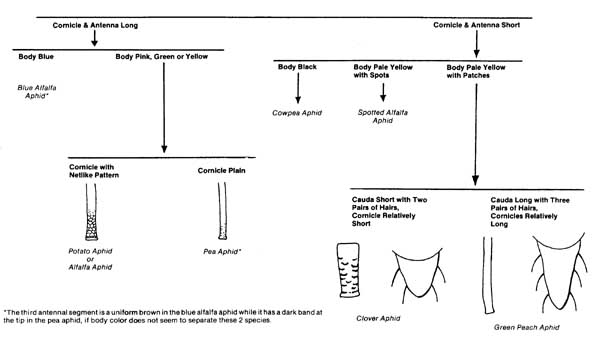 |
Figure 2: Key to aphids commonly found in Colorado alfalfa. |
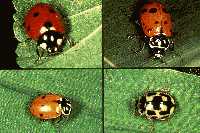 |
 |
Figure 3a: Lady beetle adult. |
Figure 3b: Lady beetle larva. |
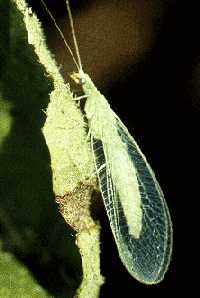 |
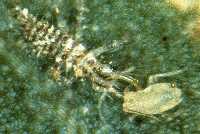 |
Figure 3c: Lacewing adult. |
Figure 3d: Lacewing larva attacking aphid. |
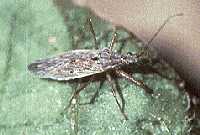 |
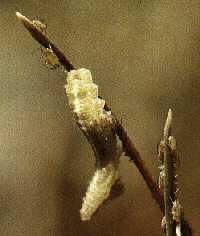 |
Figure 3e: Damsel bug. |
Figure 3f: Syrphid fly larvae feeding on aphids. |
* K.K. Kinney, former Colorado State University research associate and Extension entomologist, and F.B. Peairs, professor and extension entomologist; bioagricultural sciences and pest management. The authors thank Drs. Lynne Rieske, Boris Kondratieff and Ian MacRae for helpful comments regarding the revision of this fact sheet. 7/95. Reviewed 5/11.
Go to top of this page.





